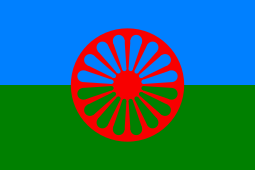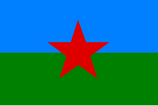 | |
| Other names | O styago le romengo, O romanko flako |
|---|---|
| Use | Ethnic flag |
| Adopted | 1971 1978 |
| Designed by | Gheorghe A. Lăzăreanu-Lăzurică (purported) World Romani Congress Weer Rajendra Rishi |
 | |
| Use | Unofficial variant |
| Adopted | 1971 |
| Designed by | Slobodan Berberski World Romani Congress |
The Romani flag or the flag of the Roma (Romani: O styago le romengo, or O romanko flako) is the international ethnic flag of the Romani people, historically known as "Gypsies", which form a stateless minority in countries across Eurasia, Africa, the Americas, and Australasia. It was approved by the representatives of various Romani communities at the first and second World Romani Congresses (WRC), in 1971 and 1978. The flag consists of a background of blue and green, representing the heavens and earth, respectively; it also contains a 16-spoke red dharmachakra, or cartwheel, in the center. The latter element stands for the itinerant tradition of the Romani people and is also an homage to the flag of India, added to the flag by scholar Weer Rajendra Rishi. It superseded a number of tribal emblems and banners, several of which evoked claims of Romani descent from the Ancient Egyptians.
Older Romani symbolism comprises insignia reflecting occupational and tribal divisions, as well totems and pictograms. In some cases, Romani "Kings" and "Princes" were also integrated within the European heraldic tradition with coats of arms of their own. As a result of this synthesis, "Egyptians" became visually associated with heraldic animals, including the adder and, in the 19th century, the hedgehog. Around 1890, affiliates of the Gypsy Lore Society had deduced that a tricolor of red-yellow-black was preferred by the Spanish Romanies, and embraced it as a generic Romani symbol. In the Balkans at large, corporate representation was granted to the Gypsy esnaf—which preceded the creation of modern professional unions, all of which had their own seals or flags. The first stages of identity politics in the 20th century saw the emergence of Romani political groups, but their designs remained attached to those of more dominant cultural nationalisms in their respective country. Into the interwar era, the various and competing Romani flags were mostly based on Romanian, Polish, communist, or Islamic symbolism.
The 1971 flag claimed to revive a plain blue-green bicolor, reportedly created by activist Gheorghe A. Lăzăreanu-Lăzurică in interwar Greater Romania. This design had been endorsed in the 1950s by Ionel Rotaru, who also claimed it as a flag for an independent settlement area, or "Romanestan". A tricolor version, flown by survivors of the Romani genocide, fell out of use due to allegations that it stood for communism. Rishi's definitive variant of 1978, with the added wheel, gained in popularity over the late 20th century; it is especially associated with groups which are advocating the transnational unity of the Romani people and combating its designation as "Gypsies". This flag was promoted by actor Yul Brynner, writer Ronald Lee, and violinist Yehudi Menuhin, and it was also adopted by "King" Florin Cioabă. It was especially popular in Socialist Yugoslavia, which awarded it official recognition upon its adoption.
The WRC Congress never provided specifications for the flag, which exists in various versions and has many derivatives, including national flags defaced with Rishi's dharmachakra. Several countries and communities have officially recognized it during the 2010s, but its display has also sparked controversy in various parts of the European Union. Derivatives were also widely used in Romani political symbolism during the same period. However, inside the scholarly community, the Romani flag has been criticized as a Eurocentric symbol, and its display as a perfunctory solution to issues which are faced by the ethnic group which it represents. It has continuously been rejected by various Romani tribes, as well as by the Ashkali and Balkan Egyptians, who form a distinct ethnicity.